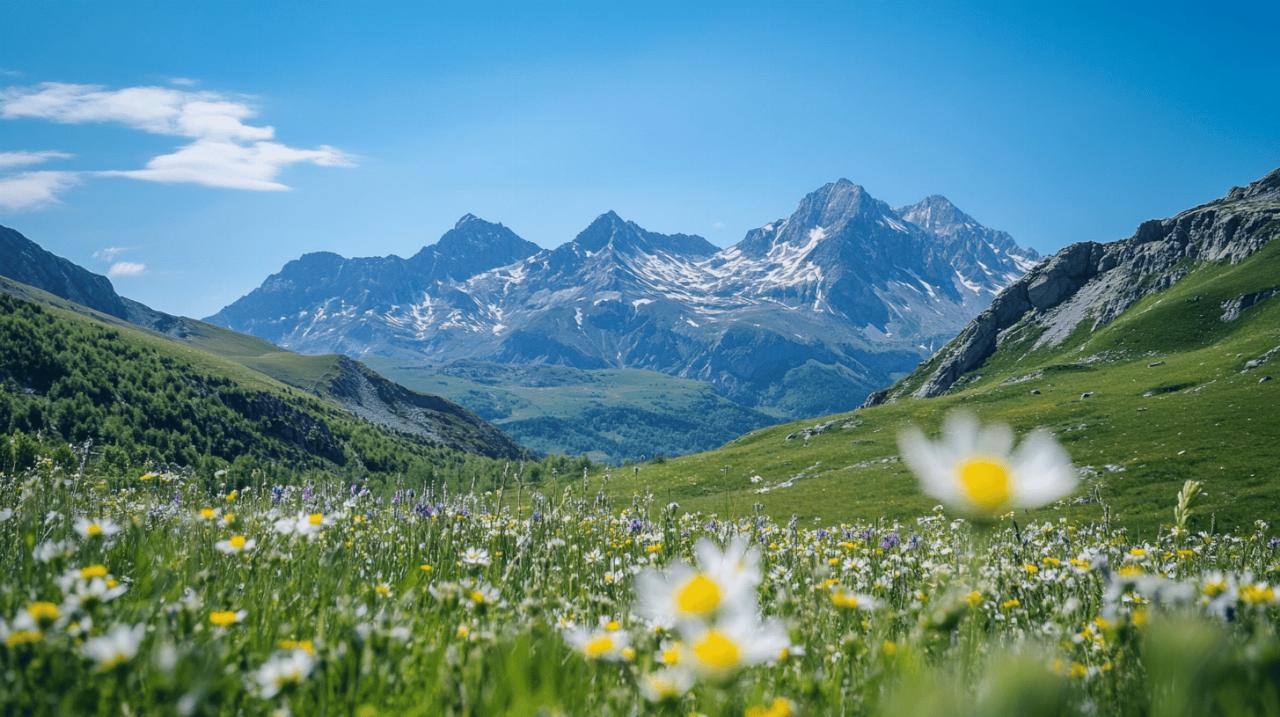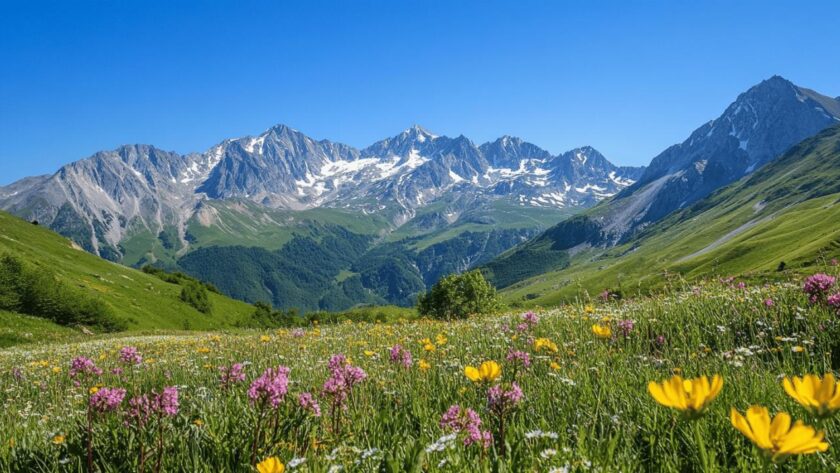Nestled in the heart of the French Alps, Pic de Bure stands as a magnificent testament to nature's grandeur, captivating explorers throughout history with its striking presence and challenging terrain. This iconic peak in the Hautes-Alpes region has been a beacon for adventurers, scientists, and nature enthusiasts seeking to experience the raw beauty of France's alpine landscape.
The Majestic Geography of Pic de Bure
Pic de Bure dominates the skyline of the Dévoluy massif, situated in the picturesque Hautes-Alpes department within the Provence-Alpes-Côte d'Azur region. As the third highest summit in the Dévoluy Mountains, this natural wonder has shaped both the physical and cultural landscape of the area, becoming a symbol of alpine magnificence.
Elevation and distinctive features
Rising dramatically to 2,709 meters (8,888 feet) above sea level, Pic de Bure boasts an impressive prominence of 1,268 meters, making it a standout feature in the Dauphiné Alps. Its distinctive lunar plateau creates a unique skiing terrain that attracts winter sports enthusiasts from across Europe. Perhaps most notably, the mountain hosts the prestigious Noema astronomical observatory (formerly known as the Plateau de Bure Interferometer) at an elevation of 2,550 meters, where 11 antennas each measuring 15 meters in diameter enable over 300 astronomers to study the cosmos from this exceptional vantage point.
Panoramic Views from the Summit
The summit of Pic de Bure rewards those who make the ascent with breathtaking panoramic vistas that stretch across the magnificent Hautes-Alpes region. Multiple access routes cater to different skill levels, including paths via Combe D'Aurouze, Combe de Mai, Superdévoluy, and the intriguing Grottes de Coste Belle. From the peak, visitors can gaze upon neighboring mountains like L'Obiou (2,789 meters) and Mont Chaberton (3,131 meters), while the surrounding landscape reveals a tapestry of alpine meadows, dramatic rock formations, and the unique geological features known locally as 'chourums' that characterize the Dévoluy massif.
Seasonal transformations and natural beauty
The majestic Pic de Bure stands tall at 2,709 meters (8,888 feet) in the Hautes-Alpes region of France, making it the third highest peak in the Dévoluy massif. This stunning landmark offers panoramic views that showcase the breathtaking beauty of the surrounding alpine landscape. Located in the Dauphiné Alps, Pic de Bure has become a focal point for both winter sports enthusiasts and summer adventurers seeking to experience the natural splendor of the Provence-Alpes-Côte d'Azur region.
The mountain transforms dramatically with the changing seasons. During winter months, Superdevoluy and La Joue du Loup winter sports stations come alive at 1500 meters altitude, with pistes reaching up to 2500 meters. The combined ski area spans over 100 kilometers with 55 pistes ranging from beginner-friendly green runs to challenging black slopes, all served by 23 lifts. Skiing on the lunar plateau of Bure offers a unique experience for winter sports enthusiasts, while snowshoeing and ski touring provide alternative ways to explore the snowy landscape.
When summer arrives, the mountain unveils a different character. The slopes become playgrounds for trail running, hiking, mountain biking, horse riding, paragliding, climbing, via ferrata, and canyoning. Multiple ascent routes make the summit accessible via Combe D'Aurouze, Combe de Mai, Superdévoluy, Grottes de Coste Belle, Pas Paul, and Tête des Pras Arnaud, catering to different skill levels and preferences.
Flora and Fauna Diversity Throughout the Year
The Pic de Bure and its surrounding areas host a rich biodiversity that shifts with the seasons. Spring and summer bring vibrant alpine flora to the mountain slopes, with wildflowers creating colorful carpets across the terrain. The region's location within Provence-Alpes-Côte d'Azur—home to four national parks and nine regional nature reserves—speaks to its ecological significance and conservation value.
The varied elevations of the Dévoluy massif create distinct habitats that support diverse plant and animal communities. From the lower meadows to the rocky summit, each zone harbors specialized species adapted to the particular conditions of altitude, exposure, and climate. This biodiversity makes the area not just a sports destination but also a natural haven for those interested in alpine ecology.
Visitors exploring the trails around Pic de Bure might encounter wildlife native to the French Alps, with populations varying throughout the year as some species migrate seasonally while others adapt their behavior to the changing conditions. The protected status of many areas within the region helps preserve these natural communities and maintains the ecological balance that makes the Hautes-Alpes so special.
Geological formations and their evolution
The distinctive profile of Pic de Bure is the result of millions of years of geological processes. With a prominence of 1,268 meters (4,160 feet), the mountain stands out dramatically from its surroundings. The Dévoluy massif, of which Pic de Bure is a part, features fascinating geological formations that tell the story of the region's creation through tectonic activity and erosion.
One of the most intriguing geological features of the area are the chourums—local term for sinkholes or potholes—that dot the landscape. These formations invite exploration and offer glimpses into the karst topography that characterizes parts of the Dévoluy region. The varied terrain, from lunar-like plateaus to steep slopes, reflects the complex geological history of the mountain.
At 2552 meters on the mountain's slopes sits the Plateau de Bure Interferometer, now part of the NOEMA astronomical observatory. This scientific installation takes advantage of the mountain's elevation and clear atmosphere, featuring 11 antennas each measuring 15 meters in diameter. Used by over 300 astronomers, this observatory highlights how the geological formation of Pic de Bure has created ideal conditions for not only recreation but also scientific research and discovery.
Scientific Value and Research at Pic de Bure
 Standing majestically at 2,709 meters (8,888 feet) in the Hautes-Alpes region of France, Pic de Bure represents more than just a stunning alpine landmark. This remarkable peak, the third highest in the Dévoluy massif, has become a global center for scientific research and discovery.
Standing majestically at 2,709 meters (8,888 feet) in the Hautes-Alpes region of France, Pic de Bure represents more than just a stunning alpine landmark. This remarkable peak, the third highest in the Dévoluy massif, has become a global center for scientific research and discovery.
The mountain's unique geographic position and elevation make it an ideal location for scientific endeavors that benefit from minimal atmospheric interference and high altitude conditions. While visitors often come to experience its natural beauty or tackle its slopes for winter sports, the scientific community values Pic de Bure for entirely different reasons.
The iram observatory and astronomical research
At 2,552 meters above sea level on the slopes of Pic de Bure sits one of Europe's most significant astronomical research facilities – the Plateau de Bure Interferometer, part of the IRAM (Institut de Radioastronomie Millimétrique) observatory. This world-class facility features 11 antennas, each measuring 15 meters in diameter, forming a powerful radio telescope array that serves over 300 astronomers worldwide.
The NOEMA (Northern Extended Millimeter Array) observatory, located at an altitude of 2,550 meters, takes advantage of the mountain's height and the thin air to conduct crucial observations of our universe. The facility's position above much of Earth's atmosphere allows astronomers to detect radio waves from distant celestial objects with minimal interference, making it invaluable for studying star formation, galaxy evolution, and cosmic microwave background radiation.
The astronomical significance of this site attracts researchers from across the globe who utilize the advanced equipment to make groundbreaking discoveries about our universe. Visitors to the Dévoluy area can appreciate not only the natural beauty of Pic de Bure but also its contribution to humanity's understanding of space.
Climate studies and environmental monitoring
Beyond astronomy, Pic de Bure serves as a vital location for climate research and environmental monitoring. The mountain's elevation and position within the Dauphiné Alps create a natural laboratory for studying alpine ecosystems, weather patterns, and climate change impacts.
Scientists track snowfall patterns, glacial movements, and temperature variations throughout the seasons, contributing valuable data to our understanding of climate dynamics in mountain regions. This research is particularly relevant given the sensitivity of alpine environments to global climate shifts.
The mountain environment around Pic de Bure showcases remarkable biodiversity that adapts to extreme conditions, offering researchers insights into ecosystem resilience and adaptation strategies. From spring wildflowers to winter snow patterns, the seasonal changes provide ongoing opportunities to study environmental responses to changing conditions.
Environmental monitoring at Pic de Bure also plays a practical role in regional safety. Météo France uses data collected in the area to produce avalanche risk bulletins by sector, helping to protect the many visitors who come to enjoy winter sports at Superdevoluy and La Joue du Loup, the winter sports stations located at 1,500 meters altitude near the mountain.
The scientific value of Pic de Bure extends far beyond its borders, with research conducted here benefiting global understanding of our planet and universe while simultaneously supporting the tourism and recreational activities that make this area of Provence-Alpes-Côte d'Azur so popular among outdoor enthusiasts.




